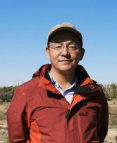
At the invitation of Professor An Chengbang and Professor Dong Guanghui from the College of Earth and Environmental Sciences, Lanzhou University and the Key Laboratory of Western China’s Environmental Systems, Ministry of Education, China, Research Fellow Guo Wu from the Institute of Archaeology, Chinese Academy of Social Sciences(IA, CASS)made an academic report. Welcome!
Title: The Northern Court in the Tang dynasty from the perspective of Archaeology
Time: October 18t, 16: 00-17:30.
Site: Lecture room 502, Qilian Building, Chengguan Campus (Western District) of Lanzhou University
Lecturer profile
Guo Wu, male, is a research fellow of IA, CASS. He mainly studies Xinjiang archaeology, Eurasian grassland Archaeology and Sino-Western cultural exchange archaeology. He is currently the deputy director of the frontier ethnic Archaeology Research Office of IA, CASS, and vice leader of the Xinjiang team.
He has been employed as a member of the Turpan studies expert committee, President of Institute of Three ponds Cultural Research, member of the Northern Court expert committee, and a specially appointed professor of "Wenjin forum" of the National Library. He has been invited to the United States, Russia, Germany, France, Sweden, Japan, South Korea, Uzbekistan, Turkmenistan, Turkey and Pakistan to attend academic conferences and carry out field archaeological work. From August 2008 to August 2009, he was a visiting scholar of Harvard Yenching. In May 2016, he was a visiting scholar in the Department of Sinology, Institute of Asian Studies, University of Munich, Germany.
He has participated in the excavation and research of mausoleums of Jin marquis in Shanxi province, The buddhist grottoes in Jianchuan, Yunnan, The buddhist grottoes in Nanjing Qixia mountain, Miaopu mountain tombs in Yunnan province, Duogang tombs, Baicheng county, Xinjiang province, Damagou buddhist temple, Cele county, Xinjiang and other sites. He presided over the excavation of Northern Court ancient city in Jimusaer county and Three ponds tombs and deer stones in Qinghe county.
Representative works: 5 books including Belief on Horseback: Animal art of the Eurasian steppe, Cultural innovation elements of Xinjiang cultural relics, and archaeological research on the late prehistoric society in Xinjiang. More than 80 representative articles, such as The spread of the second group of bronze (iron) in Eurasia, Betelgeuse and Eurasian grassland, and Mythical Animals with turnup upper lip: "Griffin" of the East.
Brief introduction of the report
The site of Northern Court ancient city is located 12 kilometers north-east of Jimusaer county, Xinjiang. The core area covers an area of 1.5km2, including the ancient city and the west temple of Northern Court. It is divided into inner and outer cities. In 1988, the Northern Court ancient city site became an important heritage site under state protection. In December 2013, Northern Court ancient city site was listed as the National Archaeological Park, the first National Archaeological Park in Xinjiang. It was listed in the World Cultural Heritage list in June 2014.
Northern Court city, which was built and expanded in the middle of the 7th century B.C. in the Tang dynasty, became the garrison of Tingzhou, Northern Court supervision office, The great Northern Court supervision office and Western Yizhou, Northern Court governors of controlling and scheduling, and eventually developed into a political, military and cultural center at the northern foot of Tianshan mountain. It was used by Gaochang Uyghur and Mongolian to the end of the Yuan dynasty and the beginning of the Ming dynasty, with a total history of nearly 800 years. It witnessed the effective rule in Xinjiang during the Han and Tang dynasties, especially the Tang dynasty, which is of great significance to the prosperity and stability of Xinjiang and the smooth flow of the ancient Silk Road.
Cen Can, a famous Frontier poet of the Tang Dynasty, wrote a series of magnificent poems during his work in Northern Court. For example, "Suddenly, like a spring breeze, thousands of trees blossomed and pear flowers blossomed." We will experience the glorious history of this thousand-year-old city with the latest archaeological discoveries.